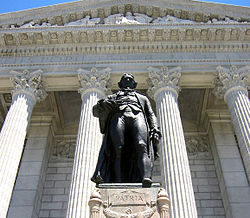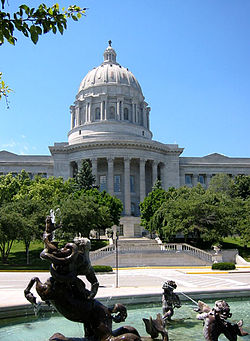- Missouri State Capitol
-
The Missouri State Capitol is located in the U.S. state of Missouri. Housing the Missouri General Assembly, it is located in the state capital of Jefferson City at 201 West Capitol Avenue. The domed building was designed by the New York architectural firm of Tracy and Swartwout and completed in 1917. It is the third capitol building in Jefferson City.
The Capitol's dome, rising 238 feet (73 m) above ground level and topped by a bronze statue of Ceres, Roman goddess of agriculture, rises above the bluffs of the Missouri River and is the first view of Jefferson City for travelers arriving from the north. In addition to housing the two legislative bodies, the Capitol houses offices for the governor, lieutenant governor, secretary of state, state treasurer, state auditor and some administrative agencies.
Contents
Architecture, paintings, and statuary
The Missouri State Capitol is notable for its architectural features, including its eight 48-foot (15 m) columns on the south portico and six 40-foot (12 m) columns on the north side; its 30-foot (9 m)-wide grand stairway and its bronze front doors, each 13 by 18 feet (5 m) -- the largest cast since the Roman era.
Statuary is a prominent feature of the Capitol grounds. Heroic bronze figures depicting Missouri's two great rivers, the Mississippi and the Missouri by Robert Aitken, and a 13-foot (4 m) statue of Thomas Jefferson by James Earle Fraser dominate the south entrance. A Karl Bitter bronze relief depicting the signing of the Louisiana Purchase by Livingston, Monroe and Marbois and the Fountain of the Centaurs created by A.A. Weinman are the most outstanding features on the north grounds.
The north side of the building contains a frieze showing the history of Missouri by Hermon Atkins MacNeil while the theme is continued on the south side by Alexander Stirling Calder. The figure of Ceres on the top of the dome is by Sherry Fry and the pediment over the main entrance is by Weinman.
The Capitol's first floor features the State Museum. Paintings, pediments and friezes decorate the Capitol interior. A prime attraction is a series of Thomas Hart Benton murals in the House Lounge. The grand staircase is flanked by large heroic bronze statues of Meriwether Lewis and William Clark, and the third-floor rotunda is the home to the Hall of Famous Missourians, a group of bronze busts of many prominent Missourians honored for their achievements and contributions to the state.
The structure also features a whispering gallery high within the dome and a small viewing platform on the dome's roof beneath the statue of Ceres. These areas are not normally open to the public except for special tours and school tours.
The capitol is Jefferson City's leading tourist attraction and is a mecca for school groups who arrive by busloads, particularly during General Assembly sessions when they fill the galleries to watch the Senate and House of Representatives in action.
The firm which designed this building also designed Ridgewood High School in Ridgewood, New Jersey.
History of structure
The present Capitol, completed in 1917 and occupied the following year, is the third Capitol in Jefferson City and the sixth in Missouri history. The first seat of state government was housed in the Mansion House, Third and Vine Streets, St. Louis; the second was in the Missouri Hotel, Maine and Morgan Streets, also in St. Louis. St. Charles was designated as temporary capital of the state in 1821 and remained the seat of government until 1826.
It was decided that the Capitol should be located more in the center of the state, and specifically, that it should be located on the Missouri river within 40 miles (64 km) of the mouth of the Osage. A group was sent out to survey various locations. The present location on top of the bluffs in Jefferson City was chosen because it afforded the best view of the Missouri River of any place which they had seen within the limits prescribed by the Constitution.
The fourth Capitol (the first in Jefferson City) was made out of brick, was two stories tall, measured approximately 40 by 60 feet (18 m), and took two years to complete. It was built for approximately $18,500. It was called the "Governor's House and State Capitol." This building burned in 1837. The site is now occupied by the modern Missouri Governor's Mansion. It was designed by Stephen Hills and modeled on the first Pennsylvania State Capitol in Harrisburg, Pennsylvania.[1] Hills also designed Academic Hall of the University of Missouri; the six Ionic columns that survived the 1892 fire that destroyed the building are now the campus's landmark columns at the David R. Francis Quadrangle).
The fifth Capitol (which is at the current site) was completed in 1840, for approximately $350,000, with some claiming that there were bribes and kickbacks. This also burned on February 5, 1911 when it was struck by lightning. This building was approximately 50,000 square feet (4,600 m2) and by 1911, was far too small to meet the needs of the legislators. Missouri Senator William Warner said, "I have no tears to shed over the fact that the building has been destroyed as it was totally inadequate and not in keeping with the requirements of our great state."
The original budget called for a building to be constructed for $3 million, with an additional $500,000 allocated for site and furnishings. This was approved in general election by the public by a three-to-one margin However, the state miscalculated on revenue projections, and ended up collecting $4,215,000. All of this money was eventually used for the entire project, which is one of the reasons why the sculptures and art work are of such high caliber.
It was also decided that the architect would be selected from a design competition; names were redacted from the submissions so that there was no local favoritism. A total of 69 architecture firms submitted for the competition, from which a short list of 11 was chosen. Tracy & Swarthout from New York was ultimately selected.
The building is symmetrical in plan, giving equal symbolic weight to both the House and Senate (though the interiors of the two chambers differ greatly). The style makes many historical references to the Capitol in Washington, D.C., as well as to Greek and Roman temples; however, the typical column capital is a unique variation on the Classic Corinthian Capital, replacing the acanthus leaves with local flora.
The stone for the exterior is a dense marble from Carthage, Missouri. Some of the finer details have eroded after 90 years of freeze/thaw cycles. The state has committed monies to study restoration and prevent further deterioration. The building measures five stories high, 437 feet (133 m) long, 300 feet (90 m) wide in the center and 200 feet (60 m) wide in the wings. The dome is 238 feet (73 m) high and the height of the wings is 88 feet (27 m). It includes 500,000 square feet (50,000 m2) of floor space.
Rotunda Chandelier Incident
In November 2006, the 9,000 lb (4,100 kg) chandelier that hangs in the dome of the building, which had been lowered almost to the floor for maintenance, fell the remaining five feet. The chandelier was damaged by the impact and by the ornamental chains that fell on it, and it was sent to St. Louis for repairs. Nearly a full year later, the chandelier was returned and raised in the capitol with the additional restoration of the upper lights, which were turned-off for four decades due to the damage the light caused to the mural above. The chandelier was created by the Guth Lighting Company of St. Louis in 1918 for a cost of $5,000 and was repaired at a cost of $500,000.[2]
Sources
- Hunter, Marie Nau, Missouri and Mississippi: Robert Ingersoll Aitken's Sculpture in Jefferson City, Missouri, Master's Thesis, University of Missouri-Columbia, 1996
- Kvaran & Lockley A Guide to the Architectural Sculpture of America, unpublished manuscript
- Semissourian.com-Chandelier incident
- Pickard, John, The Missouri State Capitol: Report of the Capitol Decoration Commission, 1917-1928, Capitol Decoration Committee, Jefferson City Missouri, 1928
References
- ^ "Stephen Hills (1771-1844)". Pennsylvania Capitol Preservation Committee. http://cpc.state.pa.us/cpcweb/hist_hills.jsp. Retrieved 2011-06-23.
- ^ Sarah D. Wire (7 November 2007). "Capitol chandelier raised almost a year after falling". Missouri Digital News. http://www.mdn.org/2007/STORIES/DOME.HTM. Retrieved 2011-06-23.
External links
- Missouri State Capitol Complex - includes touring information
- Missouri symbols - Capitol building 1177057.html
- SEMissourian: Story: 4,500-pound chandelier damaged in Missouri capitol mishap
Coordinates: 38°34′45″N 92°10′23″W / 38.579120°N 92.172991°W
State Capitols of the United States Alabama · Alaska · Arizona · Arkansas · California · Colorado · Connecticut · Delaware · Florida · Georgia · Hawaii · Idaho · Illinois · Indiana · Iowa · Kansas · Kentucky · Louisiana · Maine · Maryland · Massachusetts · Michigan · Minnesota · Mississippi · Missouri · Montana · Nebraska · Nevada · New Hampshire · New Jersey · New Mexico · New York · North Carolina · North Dakota · Ohio · Oklahoma · Oregon · Pennsylvania · Rhode Island · South Carolina · South Dakota · Tennessee · Texas · Utah · Vermont · Virginia · Washington · West Virginia · Wisconsin · Wyoming
District of Columbia · Puerto Rico
Territorial CapitolsProtected Areas of Missouri Federal National Wildlife Refuges:Big Muddy • Clarence Cannon • Great River • Middle Mississippi River • Mingo • Ozark Cavefish • Pilot Knob • Squaw Creek • Swan Lake • Two RiversNational Forests:State Babler • Sam A. Baker • Bennett Spring • Big Lake • Big Oak Tree • Big Sugar Creek • Castlewood • Crowder • Cuivre River • Current River • Elephant Rocks • Finger Lakes • Graham Cave • Grand Gulf • Ha Ha Tonka • Harry S Truman • Hawn • Johnson's Shut-Ins • Jones-Confluence Point • Katy Trail • Knob Noster • Lake of the Ozarks • Lake Wappapello • Lewis and Clark • Long Branch • Mark Twain • Meramec • Montauk • Morris • Onondaga Cave • Pershing • Pomme de Terre • Prairie • Roaring River • Robertville • Rock Bridge Memorial • Route 66 • St. Francois • St. Joe • Stockton • Table Rock • Taum Sauk Mountain • Thousand Hills • Trail of Tears • Van Meter • Wakonda • Wallace • Washington • Watkins Woolen Mill • Weston BendArrow Rock • Battle of Athens • Battle of Carthage • Battle of Lexington • Thomas Hart Benton Home and Studio • Bollinger Mill • Nathan Boone Homestead • Boone's Lick • Bothwell Lodge • Clark's Hill/Norton • Confederate Memorial • Deutschheim • Dillard Mill • Gov. Daniel Dunklin's Grave • Felix Vallé House • First Missouri State Capitol • Fort Davidson • Gen. John J. Pershing Boyhood Home • Harry S Truman Birthplace • Hunter-Dawson • Iliniwek Village • Jefferson Landing • Jewell Cemetery • Locust Creek Covered Bridge • Mark Twain Birthplace • Mastodon • Missouri Mines • Missouri State Capitol • Missouri State Museum • Osage Village • Sandy Creek Covered Bridge • Sappington Cemetery • Scott Joplin House • Towosahgy • Union Covered Bridge • Watkins Woolen MillConservation areas:List of Missouri conservation areasMissouri Department of Natural Resources Categories:- Government buildings in Missouri
- Government of Missouri
- State capitols in the United States
- Buildings and structures in Jefferson City, Missouri
- Buildings and structures on the National Register of Historic Places in Missouri
- Museums in Cole County, Missouri
- History museums in Missouri
Wikimedia Foundation. 2010.








